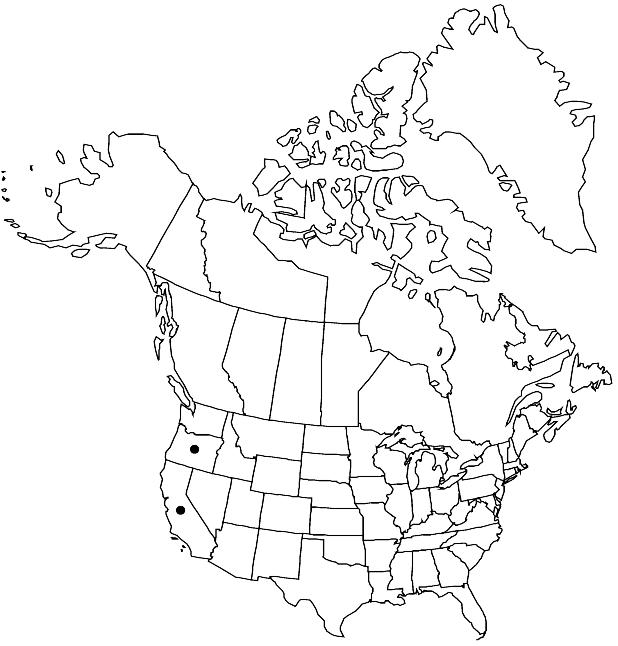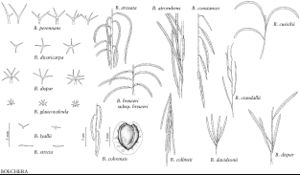Difference between revisions of "Boechera breweri"
Novon 13: 384. 2003.
FNA>Volume Importer |
FNA>Volume Importer |
||
| Line 7: | Line 7: | ||
|year=2003 | |year=2003 | ||
}} | }} | ||
| − | |basionyms={{Treatment/ID/ | + | |basionyms={{Treatment/ID/Basionym |
|name=Arabis breweri | |name=Arabis breweri | ||
|authority=S. Watson | |authority=S. Watson | ||
| + | |publication_title=Proc. Amer. Acad. Arts | ||
| + | |publication_place=11: 123. 1876 | ||
}} | }} | ||
|synonyms={{Treatment/ID/Synonym | |synonyms={{Treatment/ID/Synonym | ||
| Line 30: | Line 32: | ||
|distribution=w United States. | |distribution=w United States. | ||
|discussion=<p>Subspecies 2 (2 in the flora).</p><!-- | |discussion=<p>Subspecies 2 (2 in the flora).</p><!-- | ||
| − | --><p>Relatively few other sexual diploid species of <i>Boechera</i> co-occur with <i>B. breweri</i>, and the only currently recognized hybrid involving this taxon is <i>B. rubicundula</i> (= <i>B. arcuata</i> × <i>B. breweri</i>; M. D. Windham and I. A. Al-Shehbaz 2007). <i>Boechera breweri</i> appears to be related to <i>B. sparsiflora</i>, and some specimens of <i></i>subsp.<i> shastaensis</i> can be difficult to separate from that species. The two subspecies appear to intergrade on the western side of the Sacramento Valley from Tehama to Solano counties.</p> | + | --><p>Relatively few other sexual diploid species of <i>Boechera</i> co-occur with <i>B. breweri</i>, and the only currently recognized hybrid involving this taxon is <i>B. rubicundula</i> (= <i>B. arcuata</i> × <i>B. breweri</i>; M. D. Windham and I. A. Al-Shehbaz 2007). <i>Boechera breweri</i> appears to be related to <i>B. sparsiflora</i>, and some specimens of <i></i></i>subsp.<i><i> shastaensis</i> can be difficult to separate from that species. The two subspecies appear to intergrade on the western side of the Sacramento Valley from Tehama to Solano counties.</p> |
|tables= | |tables= | ||
|references= | |references= | ||
| Line 65: | Line 67: | ||
|publication year=2003 | |publication year=2003 | ||
|special status= | |special status= | ||
| − | |source xml=https://jpend@bitbucket.org/aafc-mbb/fna-data-curation.git/src/ | + | |source xml=https://jpend@bitbucket.org/aafc-mbb/fna-data-curation.git/src/f6b125a955440c0872999024f038d74684f65921/coarse_grained_fna_xml/V7/V7_496.xml |
|tribe=Brassicaceae tribe Boechereae | |tribe=Brassicaceae tribe Boechereae | ||
|genus=Boechera | |genus=Boechera | ||
Revision as of 20:22, 24 September 2019
Perennials; long-lived; sexual; caudex woody. Stems usually 1 per caudex branch, arising from center of rosette, somewhat elevated on woody base or from ground surface, 0.6–3.5(–4.5) dm, densely pubescent proximally, trichomes long-stalked and simple, 2-rayed (sometimes all simple), 0.4–1 mm, sparsely pubescent or glabrous distally. Basal leaves: blade oblanceolate, 3–7(–11) mm wide, margins entire or dentate, ciliate proximally, trichomes to 1 mm, surfaces densely pubescent, trichomes long-stalked, 2–4-rayed, 0.4–0.8 mm. Cauline leaves: 5–15(–28), often concealing stem proximally; blade auricles 0.5–3(–5) mm, surfaces of distalmost leaves pubescent. Racemes 7–20(–30)-flowered, usually unbranched. Fruiting pedicels ascending to divaricate-ascending, straight, 3–25 mm, pubescent or glabrous, trichomes spreading, simple and 2-rayed. Flowers ascending at anthesis; sepals pubescent; petals usually purple (rarely lavender), 7–12 × 2–4 mm, glabrous; pollen ellipsoid. Fruits ascending to divaricate-ascending, not appressed to rachis, not secund, usually curved, rarely straight, edges parallel, 3.5–10 cm × 1.5–2.2 mm; valves usually glabrous, rarely sparsely pubescent; ovules 48–96 per ovary; style 0.05–0.3 mm. Seeds uniseriate, 1.2–1.7 × 1–1.2 mm; wing continuous, 0.1–0.2 mm wide distally.
Distribution

w United States.
Discussion
Subspecies 2 (2 in the flora).
Relatively few other sexual diploid species of Boechera co-occur with B. breweri, and the only currently recognized hybrid involving this taxon is B. rubicundula (= B. arcuata × B. breweri; M. D. Windham and I. A. Al-Shehbaz 2007). Boechera breweri appears to be related to B. sparsiflora, and some specimens of subsp. shastaensis can be difficult to separate from that species. The two subspecies appear to intergrade on the western side of the Sacramento Valley from Tehama to Solano counties.
Selected References
None.
Key
| 1 | Stems 0.6-2 dm, pubescent distally; fruiting pedicels 3-8(-12) mm, pubescent; fruits 3.5-7.5 cm. | Boechera breweri subsp. breweri |
| 1 | Stems 1.8-3.5(-4.5) dm, glabrous distally; fruiting pedicels (7-)10-25 mm, usually glabrous; fruits (4.5-)7-10 cm. | Boechera breweri subsp. shastaensis |
